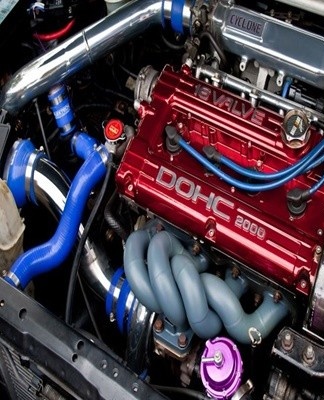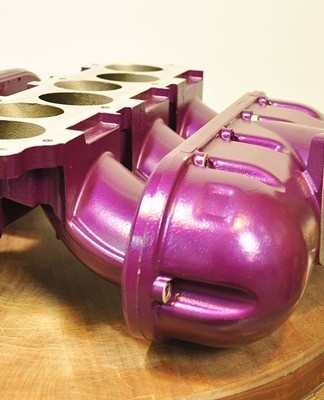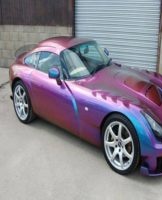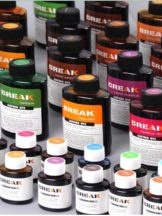Rules for choosing paint for the engine and instructions for applying it yourself
Engine painting can help improve engine appearance and extend the life of parts. The main thing is to choose the right type of paint and varnish products. Before painting, it is recommended to prepare the surface and to seal well the places through which water can infiltrate inside the engine. It is recommended to paint the disassembled engine.
Why paint the engine block
An automobile engine (internal combustion, diesel, electric) is made up of various elements and manufacturers. Most of them wear out during operation and are replaced with new ones. Some worn parts of a car engine can be painted on the outside. Painting of such elements of the engine compartment is allowed: the valve cover, the cylinder block, the outer surface of the intake and exhaust manifolds.
Metal parts are usually painted to provide additional protection against corrosion and extend their life. You can use paint to update the appearance of the engine plastic parts (plastic cover paint).The main thing is to choose the right paint material (depending on the type of surface to be painted and the operating temperature of the room).
The main reasons for painting a car engine:
- make exterior surfaces decorative (before selling the car);
- extend the life of metal elements;
- metal protection against moisture and corrosion.
It is best to combine painting with a major overhaul. It is recommended to completely remove and disassemble the motor before painting. The exterior surface of each piece is painted separately. For any engine component, select the type of paint that is appropriate for performance.
Rules for choosing a coloring composition
It is recommended to purchase heat-resistant paint for painting heated engine parts. This type of paints and varnishes can withstand temperatures up to + 400 ... + 600 ° C. As a rule, the surface of engine parts heats up to 105 degrees Celsius during operation. The valve cover can reach temperatures of +120°C. The exhaust manifold is heated to +500 degrees Celsius. Zones next to it - up to +200 degrees. The intake manifold is not exposed to strong heat.

Engine paint requirements:
- strength (after application and drying or heat treatment, the paint layer should become hard and resistant to mechanical damage);
- heat resistance (after hardening, the coating must withstand high temperatures);
- fire resistance;
- moisture resistance (the paint layer should not pass moisture);
- corrosion protection;
- the coating must be resistant to fuels, lubricants and salts;
- the cured paint layer should not crack when the temperature rises and falls frequently.
Paints and varnishes to paint the engine:
- silicone thermal paints based on silicone and solvents (for metal) - applied by spraying and brushing, hardened after heat treatment;
- dry powder heat-resistant compounds (epoxy, alkyd, polyurethane) for metal - sprayed with electrostatic spray, require "baking";
- spray cans (acrylic) for plastic - sprayed on the surface, dry naturally;
- aerosol (on organosilicon resins) for metal - sprayed on the surface, heat treatment is required;
- two-component paints (epoxy, alkyd) with hardener (for low-heat elements) - two parts are mixed before painting, the mixture is applied by brush or spray gun, hardens in the open air under the action of a product chemical reaction.
Powder coatings are considered the most heat-resistant and durable, but for their application you need a special tool, and for heat treatment ("baking") you will need an oven or infrared lamps. But these paints do not contain water, which can enter the engine and lead to corrosion.
Paint order
It is recommended to paint the engine parts only when they are dismantled. Before painting, the surface must be carefully prepared. The final result depends on the preparation.

Engine removal and cleaning
The first step is to remove the engine from under the hood. Before painting, it is recommended to disassemble the engine into its components. For spare parts that will be painted, all small parts and fasteners must be unscrewed.
First, the surface to be painted should be washed with regular dishwashing detergent and a sponge or brush. You can use a sandblaster to clean the motor.After washing, metal parts should be dried well and treated with a rust converter. Then clean again. Oil contamination can be removed with acetone or solvent. After cleaning, it is recommended to dry all the parts to paint them well.
Putty and primer
The next stage of preparatory work is putty and primer. These measures are carried out for painting parts that are not very hot during operation. To correct surface defects, use automotive filler and special primer (epoxy, alkyd). The type of primer should match the paint. Before using heat-resistant powder paints, the surface is not puttyed or primed, but only degreased, that is, wiped with acetone or solvent.
Sealing
If a dry powder composition is used, sealing, that is, protection against the ingress of moisture into the motor, is not required. Before painting the surface with liquid paint, you must first close all the holes through which the paint can enter the engine using masking tape, film.

Dyeing
The method of painting depends on the type of paint and varnish. Coloring of engine elements is carried out at positive temperature values. It is recommended to wear a respirator for respiratory protection.
When using thermal powder paint, a special tool is required - an electrostatic spray. Paint the surface in one coat. After painting, it is necessary to "bake" the coating, that is, to subject it to heat treatment. When heated to 200 degrees, the paint layer hardens during the polymerization process.Additionally, the heat-resistant paint can be activated by heating the motor at high speed.
valve cover painting
It is advisable to remove the valve cover from the engine before painting. It is best to paint on a surface covered with plastic wrap. The valve cover is often made of aluminum and coated with protective paint. The coating degrades over time. It is advisable to remove the old layer of paint with a chemical agent (stripper). Before painting, the surface should be rinsed with water, dried, sanded with tape, wiped with acetone or solvent. Let the cover dry well before applying the primer (epoxy).
Only an absolutely dry surface can be painted. The valve cover can be painted with silicone, heat resistant spray paint or two component formulations. It is recommended to apply paint materials with a fine spray in 1-2 layers. Let the coating dry well before screwing the lid back on. You may need to install new sealant for a strong, watertight connection.
Cover painting
The plastic cover can also be painted. Before painting, this part is removed from the car engine. The surface of the case should be washed, dried and sanded with tape. It is recommended to seal items that cannot be painted with masking tape.

The surface to be painted must be degreased. Once dry, the case can be primed with a plastic primer. The surface is painted with conventional plastic automotive spray paint.
Solve common problems
Some problems that occur when painting the engine, and solutions:
- if rust and old paint cannot be removed, you can use a pneumatic sandblaster;
- the liquid will not get inside the motor if the holes are sealed before using detergent solutions and liquid paints;
- Channels and openings won't clog or float with paint if plugged in or sealed with masking tape.
Additional tips and tricks
Important tips to consider when painting your engine:
- the engine elements are painted during the overhaul;
- painting of parts is carried out before assembly of the unit, and not after;
- metal and plastic are painted with different types of paint materials;
- parts heated during operation are painted with heat-resistant paint (heat treatment is required for activation);
- to obtain a uniform and uniform coating, it is recommended to use sprayers;
- before painting, the surface must be cleaned of crumbled particles, rust and degreased.



